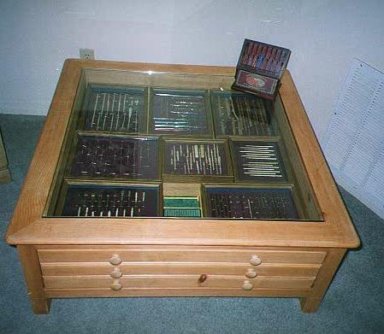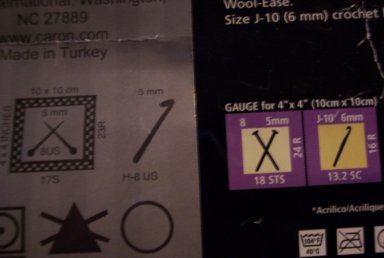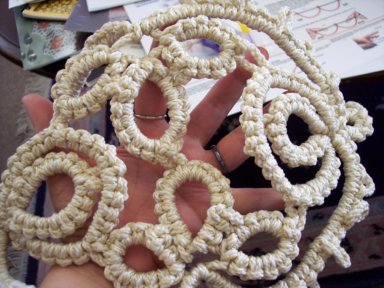When I wrote my blog entry entitled Sharing is Empowerment little did I know it would be mere hours before one of my readers would contact me and tell me there was a Chester crochet hook available for purchase as a "buy it now" ebay auction. With this reader's blessing (I wanted to ensure she wasn't interested in bidding on the auction herself), I purchased the hook immediately. {{THANK YOU, SANDY!!!!}}
Today it arrived safe and sound!
Upon ripping open the package and examining the hook, I wasn't quite sure if it's the real McCoy. I tried looking it up on the CGOA's Hook Collector's page, but the page has not been restored yet. Using the "Way Back Machine" I searched old archived pages but found no information on this hook available. I'm not sure what I was expecting -- bone perhaps? It's not. This hook feels and looks like plastic AND feels "new," as in recently manufactured. Was this hook just well stored for all these years? Was plastic being used in the early part of the 1900s?
I'm not sure of it's age, but yes, apparently plastic was being produced, and has been since the mid-1850s. According to this website, an American inventor, John Wesley Hyatt, had acquired the patent to Parkesine, a hard but flexible transparent material which is part of the cellulose family. John modified the formula to come up with an 
And, speaking of the Way Back Machine and crochet hooks, I was able to dig this image up from Brenda Beckman's former website ... it was a table she had found one day while at a yard sale (for those that live in the north east, we would call it a tag sale), for $35. It measured 4 feet by 4 feet and had interchangeable drawers allowing her to change the crochet hooks she had on display. I don't recall the specifics, but do believe she has sold off her hooks and the table. I did not get permission to use her photograph as I do not have contact information for her. I am posting it here in hopes that she won't mind because the image of that table is, in of itself, empowering. It's a testament to her love of crochet, and what we all, for those with severe Hook Acquisition Syndrome, can aspire to. :)

 I haven't figured out which pattern & fiber yet, but it did remind me that Sheila had asked
I haven't figured out which pattern & fiber yet, but it did remind me that Sheila had asked 

 or a bad, but it seems to me that there has been enough potty talk and that I should stop the bull straight away and get to my point:
or a bad, but it seems to me that there has been enough potty talk and that I should stop the bull straight away and get to my point: As you can see, I'm still not quite myself (thanks for the pic, Haley!). I feel like my head weighs as much as a city bus due to congestion. This means that I have not been able to be on the computer much to reply to emails, join in all the reindeer fun, or do some actual crocheting.
As you can see, I'm still not quite myself (thanks for the pic, Haley!). I feel like my head weighs as much as a city bus due to congestion. This means that I have not been able to be on the computer much to reply to emails, join in all the reindeer fun, or do some actual crocheting.  It seems as if fate has caught up to me. I was so proud of escaping the germs my family had tried to share with me, such as the flu in December, the stomach virus in January, the head cold in February -- I was on a roll!! So proud, so proud and healthy indeed! It was to have been the first winter in a long, long time that I would be totally germ free! ... and I was shamefully boasting about this! In retrospect, I should have waited on the boasting.
It seems as if fate has caught up to me. I was so proud of escaping the germs my family had tried to share with me, such as the flu in December, the stomach virus in January, the head cold in February -- I was on a roll!! So proud, so proud and healthy indeed! It was to have been the first winter in a long, long time that I would be totally germ free! ... and I was shamefully boasting about this! In retrospect, I should have waited on the boasting. With each experience, new connections within the brain are made. As children, those connections are made rapidly. When we reach the emotional state of adolescence some of those connections are purged; as an adult we either use it or lose it. So, keeping in mind that neural connections are made, strengthened or weakened based upon our experiences, and our age, then the answer to is teaching crochet to adults the same as teaching children, the answer is no.
With each experience, new connections within the brain are made. As children, those connections are made rapidly. When we reach the emotional state of adolescence some of those connections are purged; as an adult we either use it or lose it. So, keeping in mind that neural connections are made, strengthened or weakened based upon our experiences, and our age, then the answer to is teaching crochet to adults the same as teaching children, the answer is no. Today she can do a number of stitches, and often times makes garments for her dolls. Her attention, as of this week, is figuring out how to crochet circles (in the picture to the right she is working on a circle while awaiting for her brother at his Cub Scout Den meeting last night.)
Today she can do a number of stitches, and often times makes garments for her dolls. Her attention, as of this week, is figuring out how to crochet circles (in the picture to the right she is working on a circle while awaiting for her brother at his Cub Scout Den meeting last night.) Mom said we can add to the notebook as time goes on, like perhaps patterns we might create, or one of hers that she'll give everyone. Mom surprised us by bringing her sticker collection and letting us decorate the notebooks while we decided what to call ourselves and what we'd like to make as a group for charity. (that's one of the notebooks in the background of the picture on the left)
Mom said we can add to the notebook as time goes on, like perhaps patterns we might create, or one of hers that she'll give everyone. Mom surprised us by bringing her sticker collection and letting us decorate the notebooks while we decided what to call ourselves and what we'd like to make as a group for charity. (that's one of the notebooks in the background of the picture on the left)
 She's quite excited; every one of them is interested in working on a group charity project, so tomorrow at their first meeting they'll create an official name for their group, as well as figure out exactly what it is that they want to make together, and where to donate it. I'll have her pack up some extra supplies just in case some of the kids don't come prepared tomorrow.
She's quite excited; every one of them is interested in working on a group charity project, so tomorrow at their first meeting they'll create an official name for their group, as well as figure out exactly what it is that they want to make together, and where to donate it. I'll have her pack up some extra supplies just in case some of the kids don't come prepared tomorrow.
 When I first met Avis at the Tatting Workshop in Bethel this past weekend, she said something very interesting to me. "Dee," she said, "don't you find it interesting that you need the Internet to find your neighbor?"
When I first met Avis at the Tatting Workshop in Bethel this past weekend, she said something very interesting to me. "Dee," she said, "don't you find it interesting that you need the Internet to find your neighbor?"
 However, our instructor on Sunday strongly recommended the book pictured here on the right. I have it on my current wish list of books to acquire, but at an OOP (out of print) price tag starting at $103, I'm willing to wait. (The picture on the left is another one of the instructors pieces she had on display.)
However, our instructor on Sunday strongly recommended the book pictured here on the right. I have it on my current wish list of books to acquire, but at an OOP (out of print) price tag starting at $103, I'm willing to wait. (The picture on the left is another one of the instructors pieces she had on display.)  Yesterday I joined Avis, Marietta, Grace, and
Yesterday I joined Avis, Marietta, Grace, and  In the world of Tatting there are three techniques:
In the world of Tatting there are three techniques: I did fairly well there.
I did fairly well there.  Initially we were told that we would have the display case for the second half of the month, so when the library called the other day and said we could have it for the entire month I was one stoked crocheter!
Initially we were told that we would have the display case for the second half of the month, so when the library called the other day and said we could have it for the entire month I was one stoked crocheter! 
 When the case was complete it was time to donate some books, four total: Melody MacDuffee's "
When the case was complete it was time to donate some books, four total: Melody MacDuffee's " Leapman's "
Leapman's " But what she didn't tell you is now there's even more to celebrate! Yesterday my school principle asked me to consider creating an after school crochet club! And I'm going to do it! It will be like the "Coffee, Crochet & Chat" sessions my mom goes to every month, only this one will be for the kids in my school, and we won't be drinking coffee. I think we'll do juice and cookies instead. Even my brother, Dee Jr., is excited about this. I'm going to invite the kids that know how to knit too. My mom said that as a group we could even consider working on something for charity. I think it will be a lot of fun and can't wait to design the flyer to hand out to my classmates.
But what she didn't tell you is now there's even more to celebrate! Yesterday my school principle asked me to consider creating an after school crochet club! And I'm going to do it! It will be like the "Coffee, Crochet & Chat" sessions my mom goes to every month, only this one will be for the kids in my school, and we won't be drinking coffee. I think we'll do juice and cookies instead. Even my brother, Dee Jr., is excited about this. I'm going to invite the kids that know how to knit too. My mom said that as a group we could even consider working on something for charity. I think it will be a lot of fun and can't wait to design the flyer to hand out to my classmates.